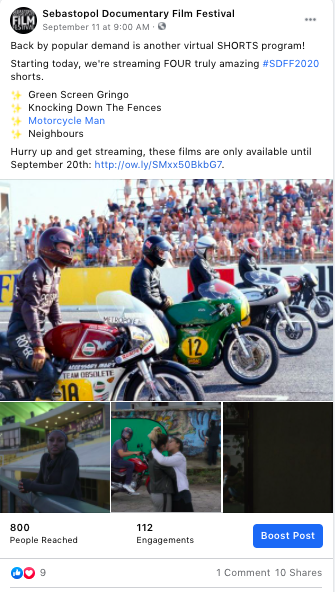If we’ve learned anything this year, it’s that things change. [Ducks]
Over the life of any client/agency relationship, there are bound to be times when strategies need to change.
Perhaps the business environment turns (for better or worse). Or the client sees an opportunity in a new area. Maybe the company’s leadership changes in the middle of a contract (it’s happened!). Then again, as happens more and more these days, the audience moves on to something entirely new.
Or — you may have read about this — a global pandemic changes everything.
We started talking to the Sebastopol Documentary Film Festival (SDFF) leadership back in 2019, signing on to help the festival drive ticket sales, foster community and set up documentary submissions for the next year.
As with every engagement, we developed a robust strategy after studying the festival world, audited SDFF’s past social activity, and checked out the competition. We defined a target audience, refined the festival’s message, and developed a timeline to match management’s goals.
We started on December 1, 2019.
On March 15, 2020 … Well, you know.
As SDFF leadership began thinking about presenting a robust festival without people traveling to Petaluma, we started to adapt our social media strategy.
While the COVID-19 pandemic is (touch wood) a once in a lifetime emergency, remaining nimble is nothing new.
So, here are some ideas on how to make your social media strategy adaptable.
#1 — Launch the strategy. Check the strategy. Refine the strategy.
Any agency should be giving clients monthly reports about engagement and traffic at the very minimum. It’s the only way an agency and the client know what’s working and what isn’t working.
A couple of wonky posts or days of engagement are one thing. A couple of weeks is quite another.
Ask these questions:
- Are we meeting our engagement/traffic/sales goals as laid out in the strategy?
- Has anything changed on the business side of things?
- What is working best?
- What’s not working at all?
- How can we amplify what’s working? Kill what’s failing?
- Is our messaging still resonating?
We’re not big believers in tossing out a strategy that made sense, but it’s essential to pivot as needed.
In the case of SDFF, many things had changed, and the goals have very clearly moved from getting butts in seats to driving eyeballs to screens. So, different strategies and tactics were required than what was initially outlined in our social strategy.
We kept what worked and threw out what no longer served us.
#2 — Be willing to experiment
Over the years, we’ve learned that there needs to be a certain percentage of flexibility in any strategy to experiment with new creative, messaging, audience engagement, targeting, etc. It’s the ole “think outside of the universe” thing.

Refuse to be stagnant.
Experimenting with video, branded images, good old text, animation, or whatever is crucial so that people don’t gloss over your content while scrolling the noisy landscape of social media.
Plus, mixing up what you’re posting helps spur the algorithm (just a big UGH that this technology is judging what’s being seen, but that’s another blog post someday) to see that your posts are helpful, engaging, and informative.
In terms of our experience with SDFF, we tested a series called #FilmmakerFriday using video, images, and images with quotes to see which worked best to drive traffic to the online programs.
What worked? Art featuring quotes from the filmmakers did the best. It also helped – and this is so important – when we had those filmmakers share and engage with the content. Leveraging those relationships is vital.
#3 — Serve before you sell

Way back at the beginning of the social media boom, one of our compadres explained that being active on Facebook, Twitter, and the like was like being at a cocktail party. Throw out a vignette, get a laugh, offer a tip. These platforms weren’t the place to see things.
Of course, that’s changed over the years, and now these platforms are sometimes the only place where people sell things.
We’re big believers in treating social media as a place to have a laugh, offer a tip, show the personal side of the business, and build a relationship. After creating some camaraderie and trust, then you can offer a service or product or whatever.
But always lead with the info before hitting ’em up for the sale.
SDFF has an impressive reputation for being a portal into all types of information and is a servant of truth. Their social media community comes to the SDFF pages to learn and be inspired.
We’ve done our best to continue the reputation that previous social media managers have built, but COVID-19 meant that online ticket sales became vital to their efforts. Over the past number of months, we’ve balanced information with marketing, and seeing what works and what doesn’t has pushed us back to point #1 in this post and adjusting as needed.
#4 — Watch the numbers
Data, buddy, data. It’s the new plastics. People of a certain age will understand that reference. Other people need to rush out and watch “The Graduate.”
Anyway. Data = numbers, and watching those numbers should be one of the essential ways to find out what’s working or not. Actually, the only way.
The easiest way to understand how the tweaks you’ve made impact your overall strategy, you need to specifically look at your average engagement rate by impressions and followers.
The numbers you find there will give you a good sense of your social performance over time. Note dips and peaks. This is also an excellent benchmark for analyzing how your social performs in coordination with other marketing strategies.
And then back to experimenting to drive better engagement. Circle of life.
Pointing back to our SDFF experience, we have been returning to some of the things we did early on in our engagement because those numbers were higher. We couldn’t do that unless we had the numbers to back up that decision, nor would we make a change based on gut.
Okay. There are four ways to make and keep your social media campaigns adaptable.
Of course, if we’ve learned absolutely anything in 2020, it’s that things change in a snap. Let’s be nimble. Let’s be quick. Let’s be smart.